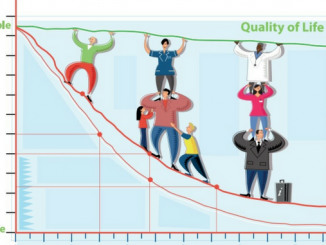It’s not just a matter of clinical outcomes: quality of life goes far beyond the final result of a cancer treatment and involves several aspects of daily life, both for patients and their caregivers. And accurate assessment is not always easy
“Survivorship requires as much attention from patient and health care professionals as the treatment of cancer” experts reminded people, stakeholders and policy makers last September, during the 2017 Head and Neck (H&N) Cancer Awareness Week. Supporting high-quality survivorship is one of the main goals of the European Cancer Patient Coalition (ECPC), which – together with the European H&N Society (EHNS) – is promoting the “Make Sense Campaign” to raise awareness of this group of rare cancers and ultimately improve outcomes for H&N cancer patients. And among these outcomes, quality of life is becoming more and more important, as highlighted during the 2018 European Congress on H&N Oncology (ECHNO; Rome, April 2018) with a whole session dedicated to the topic.
According to WHO, when we talk about quality of life (QoL), we’re talking about the “Individual’s perception of their position in life in the context of the culture and value systems in which they live and in relation to their goals, expectations, standards and concerns”.
QoL in H&N cancer: what for?

Since the beginning of the century, there has been a growing interest in QoL outcome measures in H&N cancer. As recently reported by Robert Wotherspoon and colleagues, one of the 20 most downloaded articles from ScienceDirect in 2007 was a paper listing QoL articles from 2000 to 2005 (Br J Oral Maxillofac Surg. 2018 Feb;56(2):e5-e9). Moreover, QoL assessment is nowadays part of many guidelines focused on a more comprehensive and multidisciplinary approach to H&N. “Assessing QoL is fundamental both from the patients’ and the health professionals’ point of view” said Lisa Licitra, National Cancer Institute in Milan, Italy and president of the Italian Association of Head and Neck Oncology (AIOCC). In her speech at the 2018 ECHNO Congress, she provided some clues on how QoL measurements could be used in clinical practice. “It’s not only about how the patient is coping with different aspects of disease and treatment” she explained. “It’s also about prognosis, informed treatment decisions and much more”. It was more than 20 years ago when Licitra and colleagues started suggesting that QoL information could be used to describe an expected scenario after a treatment or for decision making, i.e. computing QUALYs, a measure of the “value” of a treatment (Ann Oncol. 1997 Dec;8(12):1207-11). Twenty years later, Micaela Mercegaglia and John Cairns showed, in a systematic review, how to use QoL data in so-called “value-based medicine” for H&N cancer (Health Qual Life Outcomes. 2017 Sep 2;15(1):174). Digging deeper into the role of QoL measurement, studies demonstrated that this parameter has a prognostic significance in metastatic patients (Oral Oncol. 2012 Aug;48(8):723-9) and can be used to test research hypotheses. “Looking at the patient, we know how different therapies can affect QoL and we also know in detail that the extension and the sub-site of the tumour can modify different items of QoL” Licitra added (Support Care Cancer. 2018 Apr;26(4):1233-1242; J Natl Cancer Inst. 2018 Apr 1;110(4); Surg Oncol. 2018 Mar;27(1):23-30).
Updating patients’ priorities
At the Regional Head and Neck Cancer Centre located at the Aintree University Hospital (UK), Simon Roger and colleagues developed a Patient Concerns Inventory (PCI) specific for H&N cancer patients, a tool allowing a quick but comprehensive evaluation of patients’ needs before a consultation. It’s a collection of 56 items that a patient might want to discuss during outpatient consultation, as specified on the Merseyside Regional Head & Neck Cancer Centre website (http://www.headandneckcancer.co.uk/).
Moreover, as reported on the same website, studies have demonstrated that PCI:
- is easy to adopt with minimal disruption to the routine outpatient consultations;
- improves consultations and patient care;
- targets symptoms and facilitates referrals;
- increases patient satisfaction with consultations.
“The process takes only a few minutes while the patient is waiting to see the doctor and allows patients to underline issues which are important for them, but might easily be missed in the context of a busy outpatient consultation centre” Roger explained.
The right questionnaire at the right time
“My perception of a good quality of life can be very different from yours and we can argue if it’s really possible to measure it” provocatively declared Kristin Bjordal, Oslo University Hospital, Oslo (Norway), at the 2018 ECHNO Congress. Other than QoL itself, it is also possible to measure a more specific parameter, namely the Health-Related Quality of Life (HR-QoL), defined by the European Organisation for Research and Treatment of Cancer (EORTC) as “a multi-dimensional construct covering at least several key dimensions such as disease and treatment-related symptoms, as well as physical, psychological and social functioning”. That is to say, it’s an indication of how the patient perceives the burden of cancer and its treatment and how health is affecting general QoL. “What we immediately see when we try to evaluate HR-QoL is the tip of an iceberg: it’s the behaviour, measurable by observation” said Irma Verdonck, VU University Medical Center, Amsterdam (The Netherlands). “But patient’s distress is always multiplied by attitude, perceptions, emotions, assessable by interviews and questionnaires” she added. These questionnaires have evolved over decades and hundreds of validated measures are now available to assess different dimensions of HR-QoL, from functional to emotional and social issues. EORTC QLQ-H&N35 is one of the most commonly used, but – as reported in the The Journal of Laryngology & Otology (J Laryngol Otol. 2016 May;130(S2):S49-S52) – “there is no gold standard questionnaire and each has its own unique features and merits” (Table 1). “The take-home message is that measuring QoL is a science, it is not something we can do in our kitchen” Licitra stated.
Table 1 – Common questionnaires by type
QUESTIONNAIRE General EuroQol-5D (EQ-5d) 7 General cancer The European Organisation for Research and Treatment of Cancer C30 (EORTC C30) Functional Assessment of Cancer Therapy: General (FACT-G) Specific to head and neck cancer EORTC H&N35 University of Washington Quality of Life (UWQoL) Functional Assessment of Cancer Therapy- head and neck (FACT H&N) Specific to function of the head and neck The MD Anderson Dysphagia Inventory (Dysphagia MDADI) The voice-related quality of life (V-RQoL) measure The Liverpool Oral Rehabilitation Questionnaire (LORQ) Neck Dissection Impairment Index (NDII) SYDNEY Swallow questionnaire (SSQ) Other Hospital anxiety and depression scale (HADS) Derriford Appearance Scale 24 (DAS 24) Source: Modified from Table 4; Wotherspoon et al. (Br J Oral Maxillofac Surg. 2018 Feb;56(2):e5-e9).

Toward a more “patient-centered” approach
Together with QoL and HR-QoL questionnaires, Patient-Reported Outcomes Measures (PROMs) represent a powerful instrument for comprehensive patient care. By definition, PRO is any report of a patient’s state condition that comes directly from the patient, without interpretation by a clinician or anyone else. It’s a raw and “unfiltered” evaluation of QoL. “It is an umbrella term that covers a wide range of potential measurements” Bjordal explained. When it comes to choosing the best instrument to measure QoL, “I think it’s not a question of HR-QoL questionnaires or PROMs” said Bjordal. “It’s a question of and, and of a combination of them”. As for the HR-QoL questionnaires guidelines and review are available on how to use PROMs and to understand if they are useful in a specific scenario. “COSMIN guidelines and COSMIN methodology can help with PROMs” Bjordal claimed (Qual Life Res. 2018 May;27(5):1147-1157; Qual Life Res. 2018 May;27(5):1159-1170).
What patients want
As a matter of fact, when asked about their concerns, the majority of cancer patients say survival is the real priority. But this is just the beginning of a very long story starting with the diagnosis. Needs and priorities change over time and depend on cancer type and treatment. A recent study demonstrated that almost 7 out of 10 (68.6%) cancer patients need to feel like they are managing their health together with the medical team and that 6 out of 10 (62.5%) want information provided in a way they can understand, but many patients have emotional needs, like a group or person with whom they feel safe expressing how they really feel (50.1%) (J Fam Pract. 2014 Oct;63(10):E7-16). What about H&N cancer patients? Not surprisingly, some of their needs overlap general cancer patients’ needs, but some others are directly related to the burden of their specific cancer. Pain, sexuality, coughing, voice, eating, diet, aspiration, astenia, swallowing, hearing, and changes in facial appearance are some of the biggest issues for H&N cancer patients (Adv Clin Exp Med. 2014 Nov-Dec;23(6):1019-27). And please, don’t forget the caregiver. After a diagnosis of H&N cancer, caregivers may suffer from psychological disorders like anxiety or depressive symptoms due to the chronic burden of caring – both physically and psychologically – for the patient (J Psychosom Res. 2017 Sep;100:29-34). “Taking care of the carers” is fundamental also in terms of patients’ QoL, as data shows that family and carers have a big impact on HR-QoL of H&N cancer sufferers (Br J Oral Maxillofac Surg. 2018 Feb;56(2):e5-e9).
HaNDLE-on-QoL: a glimpse of the literature
How can you find information about QoL in H&N cancer? Unfiltered and generic searches of scientific literature can ultimately lead to inappropriate results, and could be time-consuming in a context where the ability to search and compare results rapidly is important both for clinicians and researchers.
That’s why some searchable tools can be useful.
HaNDLE-on-QoL (Head and Neck Database Listing Evidence on Quality of Life) is a database including abstracts from all relevant papers – from 1982 and constantly updated – that used questionnaires to report on QoL in H&N cancer patients. “It is a useful point of reference for those involved in clinical practice or research” claim the authors.
Here is a summary of its contents as of May 2017, as reported by Robert Wotherspoon and colleagues (Br J Oral Maxillofac Surg. 2018 Feb;56(2):e5-e9).
- Papers. A total of 1,498 papers (including 149 reviews) are listed, with the number of hits rising in time from 32 in 2002 to 185 in 2016.
- Cancer sites. Most of the papers referred to a combination of H&N cancer subsites (n=871); 187 specifically referred on oral sites and 109 on the larynx.
- Topics. “Swallowing” (n=353), “speech” (n=299), “pain” (n=292), ”emotions” (n=226) and “depression” (n = 193) were among the most common topics. Among other common keywords, “eating”, “anxiety”, “dysphagia”, “information”, “xerostomia” and “diet” were found in more than 100 papers.
- Questionnaire. The European Organisation for Research and Treatment of Cancer C30 (EORTC-C30, n=369), the EORTC-head and neck 35 (EORTC H&N35, n=353) and the University of Washington Quality of Life (UWQoL, n=276) were the most commonly used among the over 250 questionnaires included in the database.





